5 Fast Cardio Exercises You Can Do At Home Without Equipment
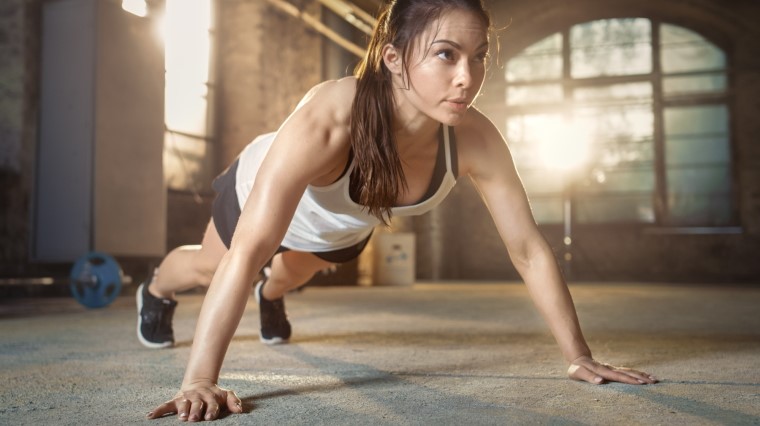
Going gym-free doesn't mean your attitude to fitness has to falter. These fat-burning cardio exercises require only your body and can literally be done anywhere.
Our top cardio exercises are fast in three different ways – in the time it takes to complete them, in the explosiveness of key steps and in their ability to strengthen major muscle groups required to generate speed.
Whether you’re short on time or space, these full-body exercises are ideal for energising your mornings and breaking up long stationary periods working from home. They elevate your heart rate and burn fat fast – making them a staple in your home HIIT workouts.
Once you’ve mastered correct posture (we’ll take you through this step by step), you should aim to do these cardio exercises fast but controlled.
For speed training, measure a completed set by time rather than reps. The duration of time suggested for each exercise is a guideline. Depending on your fitness level, aim for around 3 – 6 sets.
Jumping Jacks

Jumping jacks are your equipment-free exercise to get your blood pumping anywhere. This full-body exercise activates your major muscle groups including your calves, thighs, glutes, upper back, core, shoulders – and let’s not forget your heart.
Jumping jacks are effective as both a warm-up activity to kick-start your body into cardio mode or as full-blown HIIT workout.
Difficulty level: Beginner
How to:
1. Stand up tall with your arms straight down alongside your body and head facing forward. Engage your core.
2. With knees slightly bent, jump both feet out to the sides and raise your arms above your head in a single motion. Your feet should be more than shoulder-width apart, landing softly and quietly with your core still activated.
3. Immediately after landing, reverse the motion by jumping back to the standing position with feet together and arms by your sides in step 1. Repeat.
For speed training, perform jumping jacks at full speed for 1 minute per set. Take a 30 – 45 second rest between sets.
High Knee Sprint
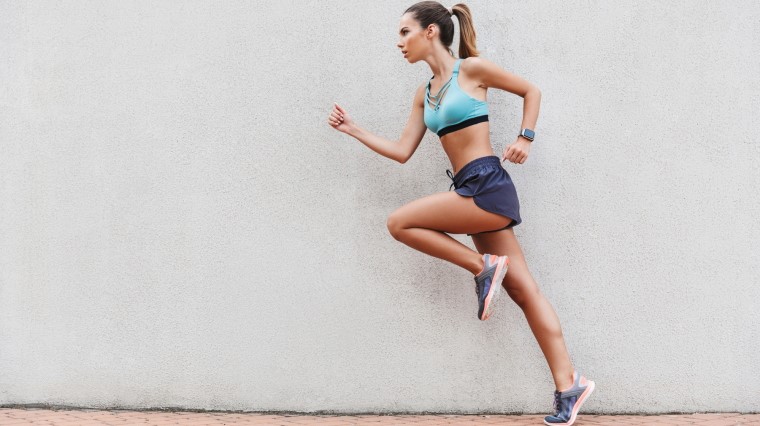
High knee sprints are a leg-busting exercise that fits seamlessly into your HIIT sessions, delivering cardio and fat-burning benefits in a short burst of time.
It is a more explosive, speed-driven movement compared to standard running and activates your calves, quads and core. High knee sprints get your blood pumping and improve your dynamic flexibility – that is, your ability to fully and effectively engage your muscles and joints while in motion.
Difficulty level: Beginner - intermediate
How to:
1. Stand with feet shoulder-width apart and a straight torso, with your arms by your sides.
2. Raise one knee up to your hip height, with thigh parallel to the ground. As you knee lift, pump the opposite arm alongside your body for balance, with your elbow at a 90-degree angle. Lower your knee and straighten your leg until your foot contacts the floor, landing softly.
3. Immediately follow with step 2 for the opposite leg and repeat. Perform knee lifts steadily and controlled on the spot until you are familiar with the 'marching' motion. Be wary of your posture and avoid slouching.
4. Increase speed to transition into a swift, high knee sprint. Focus on the speed and height of your knee lifts while keeping your torso upright and shoulders back.
High knee sprint at full effort for 30 seconds. Take a 30 second rest between sets.
Mountain Climbing Plank
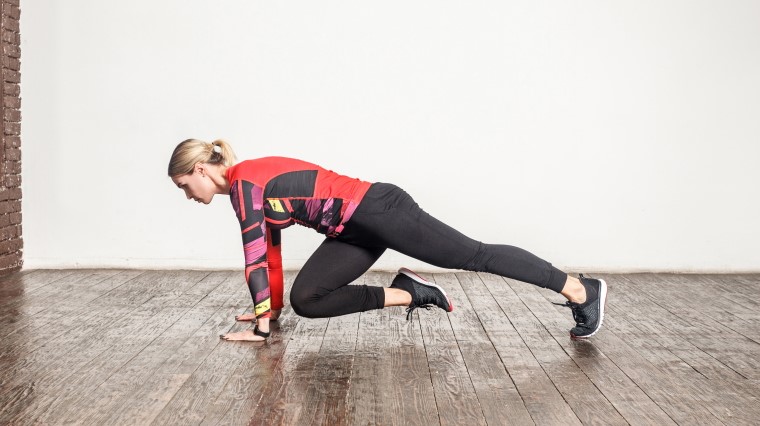
Otherwise known as the “running plank”, the mountain climbing plank is a staple in circuit training and HIIT workouts. It’s effective in elevating your heart rate, core-strengthening and toning your hamstrings, quads and glutes when performed correctly.
The fluid, repetitive motion of your legs improves your joint flexibility, increasing the mobility of your hips and knees while giving your heart a workout. The goal is speed without compromise to form for full cardio benefits.
Although your upper body remains still and grounded during this leg-burning exercise, it’s not just about the lower body. Your chest, spine, arms and shoulders have a key role in keeping your body stabilised and supported, building your upper body strength.
Difficulty level: Intermediate
How to:
1. Position yourself on all fours, supported by your hands and knees with your hands in line with your shoulders and knees beneath your hips.
2. High Plank Raise your knee off the floor and step your foot behind you one leg at a time, supporting your body by pressing the balls of your feet and palms to the floor. Keep your eyes on the floor to prevent overextending your neck. Aim for a neutral line from head to heels, with no arching or dipping of your spine. Keep your core engaged, glutes tight and upper body stable.
3. Mountain climbing Pull one knee towards your chest, then lengthen your leg back to the high plank position in step 2. Once your foot is stable behind you, immediately drive your opposite knee towards your chest. Continue alternating between legs.
4. Once you’re confident in your form, increase speed for a more explosive workout.
Perform the mountain climber at full effort for 30 seconds – 1 minute. Take a 30 second rest between sets.
Split Lunge Jump
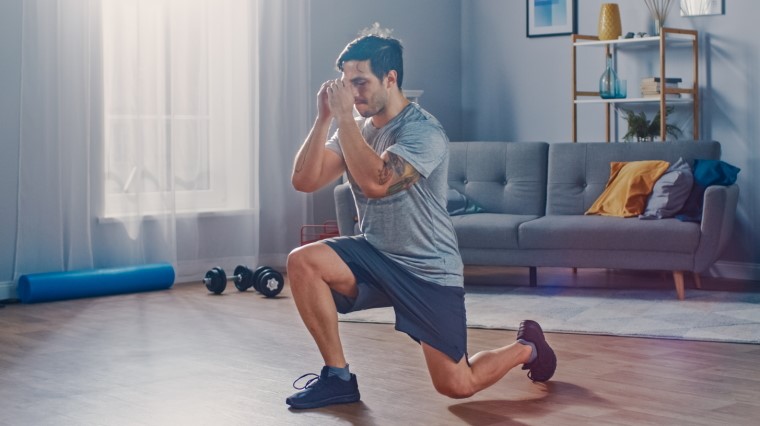
The split lunge jump turns the basic lunge into an explosive cardio session and is a killer exercise for your lower body and core. The plyometric ‘jumping’ element engages your muscles to generate power – translating to increased speed and strength.
The moment you put your body to the test in a split lunge jump, you’ll recognise that balance is critical. Performing split lunge jumps as part of your HIIT workouts will improve your coordination and agility as you repetitively switch between the alternate lunge stances.
Difficulty level: Advanced
How to:
1. Stand tall with feet shoulder-width apart and arms alongside your body. Engage your core.
2. Take a generous step forward with your right leg, keeping your knee slightly bent and torso centred.
3. Lunge Transfer most of your weight forward to your right foot, with your right heel flat on the floor and the heel of your left, back foot raised. Lower your hips into the lunge. Check-in with your posture – the knee of your front (right) leg should at a 90-degree angle, with thigh parallel to the ground. Your shoulders should be in line with your back (left) knee.
4. Jump, pushing off with both feet and alternating their position swiftly in mid-air, bringing the left foot in front of your body and right foot behind your body. Aim to gain height in your jump for a smooth transition.
Simultaneously pump your arms during the jump, moving arms in sync with opposite legs or mirroring the same arm movement on each side of your body, with arms pumping forward and back together. Using your arms effectively will improve your balance while adding momentum and an explosive element to the movement.
5. Land softly in an alternate lunge position to step 3 (left foot forward, right foot back), lowering your back knee to just above the floor. Repeat.
Alternative: For beginners, step rather than jump between lunges until you gain confidence in your posture and gain familiarity with the movement.
Perform split lunge jumps for 30 seconds – 1 minute. Take a 30 – 45 second rest between sets.
Burpees
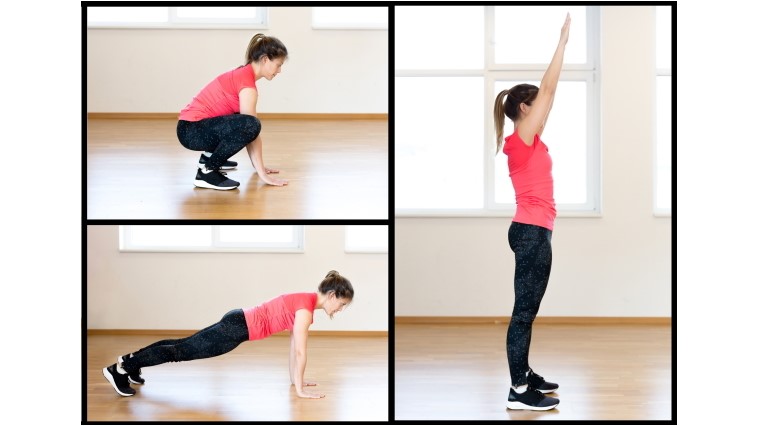
Burpees are your advanced, full-body exercise, targeting nearly all major muscle groups and boosting your cardio health, speed and strength.
Multiple dynamic movements threaded into one, this muscle-building exercise is an essential addition to your HIIT workouts – with the focus being on speed.
For burpee beginners, break it down into the steps to master the correct posture in each element individually. Perform the entire rep slowly and fluidly to gain a feel of the motion before focussing on speed and the explosiveness of each step.
Difficulty level: Advanced
How to:
1. Squat Stand tall with feet hip-width apart, chest up and arms alongside your body. Keep your feet planted on the ground, with weight supported by the heels and balls of your feet. Engage your core.
Lower your body, hinging at the hips and bending your knees until your thighs are parallel to the floor in a squat position. Focus on keeping your back neutral - imagine a pole connecting your head and tailbone to prevent your spine from hunching or arching. Place your hands palms down on the floor, with arms between your knees.
2. High Plank Using your hands as support, kick both feet straight backwards, jumping them away from your body into a high plank position. Maintain a neutral line between head and heels, with shoulders directly above your wrists and your lower body supported by the balls of your feet.
3. Push-Up Keep your core engaged and shoulders relaxed. Lower your body, with your elbows forming a 90-degree angle and chest close to the floor. Keep your lower body stable by pressing your toes into the ground during the motion. Push your body away from the floor with your palms, straightening your arms and keeping your core activated as you return to the high plank position.
Alternative: Replace the single push-up for mountain climbers to add variety to your burpee. For burpee beginners, step 3 can be skipped entirely.
4. High Plank Frog Jump Jump your feet forward into a squat position, landing gently with arms between knees and hands remaining pressed to the floor. Your knees should be bent and directly above your toes.
5. Jump Squat Jump explosively straight up, with core engaged and generating power from your legs. Raise your arms above your head or keep them by your sides if preferred. Aim for a soft and controlled landing, transitioning back into the squat position in step 1. Repeat.
Perform burpees for 30 seconds – 1 minute. Take a 30 – 45 second rest between sets.
The Wrap Up
Keeping on track of your fitness goals is less about having the right equipment and more about having the right attitude. Especially in lockdown, it's important to prioritise your physical and mental health, to fuel your motivation and stay primed for your sport.
These heart-pumping cardio exercises not only challenge your body to move fast in short bursts, but strengthen the major muscles groups necessary to push for more speed. You can train to increase your speed and cardio health on the spot – translating to improved performance in running, cycling, netball, football, swimming and virtually any sport.
Warm-up and take your time to ensure proper form for each step before focussing on speed. For beginners, train in front of a mirror to stay aware of your posture and body alignment. Soft surfaces like grass or an exercise mat may reduce the stress to your joints when doing explosive movements or HIIT workouts.
Please consult with your doctor before beginning any exercise program. Your personal trainer can guide you one-on-one on how to maintain correct form and perform these cardio exercises safely.
